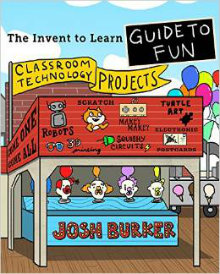Get Elbow Deep in Maker Learning Fun
The Invent to Learn Guide to Fun
By Josh Burker
(Constructing Modern Knowledge Press, 2015 – Learn more)

For more than a year, I have had two small boxes sitting on a counter in our house. One contains a MaKey MaKey set, which is a sort of a low-scale inventors’ kit. The other small box contains a Squishy Circuits set, in which you make your own dough that conducts electricity.
I purchased the sets at different times, but in the same frame of mind: I wanted to explore making something cool that would mesh hands-on learning with technology. I’m reluctant to admit it, but both boxes have remained mostly unopened since their arrival to my house.
Josh Burker’s The Invent to Learn Guide to Fun book might just change all that for me.
Intriguing projects of varying complexity

There is still a bit of a learning curve here, particularly as Burker shares how to integrate software like Scratch and TinkerCAD into hands-on projects like making your own game of Operation, or creating musical instruments via MaKey MaKey, or crafting 3D art tiles with Turtle Art programming, or even designing your own “Adventure Crawl” game that uses the computer and sensors so that you can use live action exploration in conjunction with Scratch programming.
Read an excerpt from the Invent to Learn Guide to Fun
What is helpful is that Burker lays out the complexity of each project at the very start, so you know what you are getting into, and then provides a materials list, before proceeding to detailed instructions (including hints on what can go wrong and how to “hack” around the problems). There are plenty of links to online videos and resources. The inclusion of project images and computer screenshots, and pictures of kids in the act of the making, is a welcome addition to the text and a real boost to the idea that “Hey, I can do this, too.”
Teachers should take time to play
I honestly don’t know if I will be using a 3D printer anytime soon (but I hope so) and the adventure game programming activity seems a bit of a reach right now, but surely, I can open up my MaKey MaKey kit and/or my Squishy Circuits set and have a little fun while considering the applications that might work well in my own sixth grade classroom.
What’s important is that teachers find the time to play, preferably in spaces with other teachers, and be reflective on learning practices. Burker’s book is a handy guide on where one can start with these kinds of engaging projects. Give it a try. Make something cool. I’ll try it, too.
Kevin Hodgson is a sixth grade teacher in Southampton, Massachusetts, and a co-director of technology with the Western Massachusetts Writing Project. Kevin blogs regularly at Kevin’s Meandering Mind and tweets more often than is healthy under his @dogtrax handle.



































